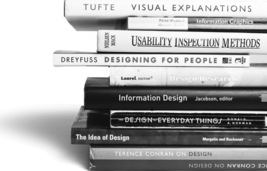Introduction
 |
This is a text intended to contemplate the theory behind the field of Interaction Design in a new way. There exist a number of texts that have already explored Interaction Design. Some of these consider the role of design in Human-Computer Interaction, a field bounded by Cognitive Psychology and Computer Science. These texts usually describe the nature of design as related to a user-interface design on a screen—emphasizing the specific elements that show up in an interface, or examining examples of best practices, heuristics, or guidelines for creating interfaces. This type of text is frequently found in schools of computer science and may actually be used as a textbook for engineering students interested in understanding the human-level repercussions of their actions.
Other texts explore the nature of design as related to the creation of two, three, or four dimensional forms. These texts look at aesthetic and emotional value provided by various shapes, compositions, or arrangements of elements. The mechanism for explaining formal choices is usually by example—showing a physical product, or demonstrating a particular interactive piece—illustrating the result of design work in a graphical way that emphasizes beauty and elegance. This type of text is often found in schools of design or fine arts and may be used to illustrate a historical precedence for a particular stylistic movement.
There are, however, few texts that explore the semantic connections that live between technology and form which are brought to life when someone uses a product. These connections may be thought of as “interactions” or “experiences”, and are beginning to hint that a field known as Design (with a capitol “D”) is a legitimately separate area of study alongside Science or Art. This text attempts to live in this area—to consider and reflect on the more theoretical and conceptual aspects of Interaction Design.
The author is fully aware that practicing Interaction Designers may find the contents of this text to be “high-level” or seemingly void of pragmatic or immediately applicable use. The purpose of this text is not to provide tools that can be applied in the role of day-to-day Inter-action Design operations; other books do this quite well.
Instead, it is the primary goal of this text to better define Interaction Design: to provide a definition that encompasses the intellectual facets of the field, the conceptual underpinnings of Interaction Design as a legitimate human-centered field, and the particular methods used by practitioners in their day-to-day experiences. This definition and investigation centers around the issue of argument and rhetoric, and illustrates that Interaction Design is a form of communication that can be thought of as identical in nature to language. As Interaction Design is a vast subject, this text attempts to touch on many topics in a slight manner rather than one topic in a deep manner.
An additional goal of this text is to assure practicing Interaction Designers that they are not, in fact, simply tools to be used in the cleanup phases of a technology-centered project. Interaction Designers need to possess a great intellectual capacity for complicated problem solving, for dynamic inquiry relating to technology, and for substantial empathy of the human experience. This intellectual insight is ideal for solving strategic business problems and for humanizing technology, and the creation of “pretty interfaces” is perhaps the most blatant misuse of this critical resource.
A final goal of this text is to provide Interaction Designers with the vocabulary necessary to justify their existence to other team members: to engineers, to marketers, and ultimately, to management. Without this justification, these advocates for the humane manifestation of technology may end up as simple cogs in the wheel of technological progression.
Designers of all breeds bemoan their lack of representation in industry—they claim to be misunderstood, underpaid, and relegated to stylist or pixel pusher. If designers are, in fact, stylists, then they deserve to be paid to style: to create a temporary visual feeling that is transient and cheap. But Interaction Design is not about a transient aesthetic. A “cool flash interface” defines Interaction Design in the same way that accounting defines strategic business development—not at all. Interaction Designers are trained to observe humanity and to balance complicated ideas, and are used to thinking in opposites: large and small, conceptual and pragmatic, human and technical. They are the shapers of behavior. Behavior is a large idea, and may, at first blush, seem too large to warrant a single profession. But a profession has emerged nonetheless. This professional category includes the complexity of information architecture, the anthropologic desire to understand humanity, the altruistic nature of usability engineering, and the creation of dialogue.
While there is now a need for this profession in business—perhaps to truly drive business—the value of Interaction Design is not in the creation of profits; these are incidental. The value is, instead, in the development of human-centered designs and in the creation of a framework in which to experience these designs.
..................Content has been hidden....................
You can't read the all page of ebook, please click here login for view all page.
